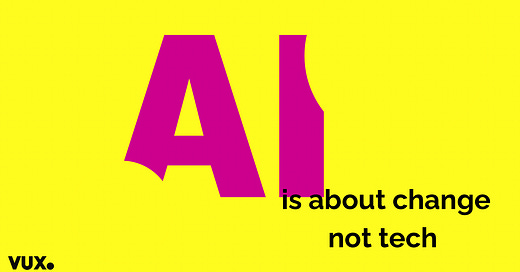Why AI is about change, not technology
Implement whatever AI tech you want, if your people aren't involved, it's going nowhere.
AI is a change project, not a tech project. Why? Because success doesn’t rely on how good the technical solution is. It relies on how well it’s adopted.
Think of any AI solution you could use in your organisation and I’ll wager that it will impact someone’s job somewhere. And how will they view your flashy technology? As a threat? Probably. What about management? Will your solution make a manager’s headcount reduce from 50 to 20? If so, how do you think they’ll take it?
Like it or not, regardless of how ready the technology is, you’re dealing with egos, empire building, job protection, impulsive and defensive behaviour, a lack of trust, a lack of understanding and big concerns about individual jobs… It’s culture. Hearts and minds.
You see, you could build the best AI sales assistant the world’s ever seen, but if your sales team aren’t on board, it’s useless.
You might have the best procurement AI agent imaginable, but if your procurements team see it as a threat to their livelihood, they simply won’t use it.
You could have the best customer service AI capability customers have been dreaming of, but if the Contact Centre manager views it as a threat to their empire, they’ll do whatever they can to prevent it.
Making it a success
To make AI a success long term in a way that transforms your business, you need to bring your people with you. You need to change the culture. You need to manage change. To do that, you need to accomplish four crucial things:
Involve the department from the outset. No one wants anything to be done to them. They’ll feel like they’re not in control. It’s their job. Their department. Their process. If they’re not in control, you’ll fail. Once you’ve implemented your new flashy solution and you turn around to walk out of the door, you’ll see the team drift straight back into their old habits, circumnavigating the system with workarounds or just defaulting back to the way they’ve always done it. You have to get support from the outset and that starts by involving the right people.
Focus on solving their problems. Don’t mention the word AI in any of your initial meetings with the team, management or stakeholders you’re working with. Instead, focus on figuring out what their problems are. What problems do customers have? What research or data do you have to support this? What problems are staff facing? The boots on the ground that manage the current processes and systems, what prevents them from doing their job or wastes their time? If you can encourage the team to offload on you, and share their biggest pain points, you’ll have something you can focus on. Common ground for you both to come together to solve.
Give the project ownership to the most senior stakeholder in that department. Imagine you work in IT, or innovation or some other department, and you’re building an AI agent to help the sales team close more leads. Who should own that project? Most of the time, it’s a Product Owner that works with the tech team building the solution. Both the PO and the team are working with the sales team to build the solution. However, this solution will start to impact sales KPIs over time. Plus, it needs to be used by all sales agents for it to be successful. So who should own it? Well, it’s the most senior person responsible for sales. They should be the ones prioritising the backlog, signing off on features and determining quality. It should be their solution, and the tech team are working for them in service of their needs. This is the trick to making it work longer term. Give ownership to the team that’ll use it.
Take your time, step by step. On day one, you might have a brilliant idea to automate a specific area from end to end. The solution might seem perfectly obvious to you. And the tech might exist to make it happen easily. However, the business area you’re working with might not be ready for such drastic change. Instead, scale the solution back to the simplest piece that you could implement first as a way of taking a step in the right direction. When UPS implemented its AI parcel sorting and route planning, it didn’t start with the full solution, even though that was always the end game. It started just with parcel sorting to show the team there’s value and get the process embedded. Then, it added route planning incrementally. Whatever’s possible technically is different what what’s possible culturally. Take it one step at a time.
If you started with a blank piece of paper and set out to describe the future of your organisation, I’d wager your description looks completely different to the current reality. To go from where you are to where you want to be, you wont be limited by technology, you’ll be slowed down by your people, processes and culture. Changing that is what AI is all about, really.




